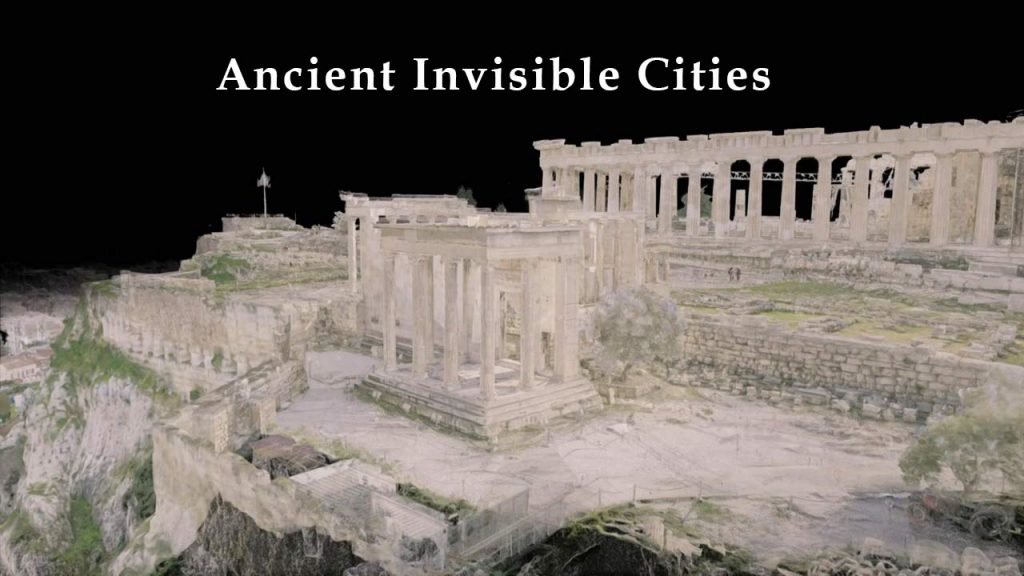Ancient Invisible Cities episode 2 – Athens: Michael Scott uses the latest 3D-scanning technology to reveal the historical secrets of ancient Athens and tell the story of how this remarkable city created the world’s first democracy two and a half thousand years ago. He begins his journey on the Acropolis, where, in the late 6th century BC, the people of Athens overthrew a tyrant and set up the world’s first democracy. There, he investigates a mysterious, asymmetrical temple called the Erechtheion that sits in the shadow of the world famous Parthenon. Decoding the stories from ancient Greek mythology that were built into this temple, he reveals it to be one of the most important buildings of Ancient Athens.
Michael journeys into the landscape surrounding Athens, to the area of Laurion, 50 miles to the south of the city. He explores inside one of the ancient silver mines that dot this landscape, where an army of slaves once worked in silver production, toiling inside the labyrinth of tunnels, digging silver ore by hand for the good of the city above. He discovers a network of tunnels and galleries barely high enough to crawl through. He reveals that here, in the 480s, the miners hit upon a seam of silver that proved a massive boost to Athens’s new democracy. He discovers how democratic Athenians voted on what to do with this money and instead of distributing it among the citizens, decided to invest it in a fleet of warships just in time to tackle a massive invasion force from Persia.
Michael takes a ferry to the island of Salamis, to investigate a harbour where the Greek fleet – including the new Athenian warships – gathered to prepare to take on the Persians. The battle that followed, the Battle of Salamis is considered by many scholars to be one of the most important battles of the Ancient world. Athens and its allies faced a force said to be three times their size and had Athens been defeated, its young, precarious democracy could have been lost to history. He tells the story of the battle and discusses new archaeological remains that date from that time.
Ancient Invisible Cities episode 2 – Athens
The oldest known human presence in Athens is the Cave of Schist, which has been dated to between the 11th and 7th millennia BC. Athens has been continuously inhabited for at least 5,000 years (3000 BC). By 1400 BC, the settlement had become an important centre of the Mycenaean civilization, and the Acropolis was the site of a major Mycenaean fortress, whose remains can be recognised from sections of the characteristic Cyclopean walls. Unlike other Mycenaean centers, such as Mycenae and Pylos, it is not known whether Athens suffered destruction in about 1200 BC, an event often attributed to a Dorian invasion, and the Athenians always maintained that they were pure Ionians with no Dorian element. However, Athens, like many other Bronze Age settlements, went into economic decline for around 150 years afterwards.
Iron Age burials, in the Kerameikos and other locations, are often richly provided for and demonstrate that from 900 BC onwards Athens was one of the leading centres of trade and prosperity in the region. The leading position of Athens may well have resulted from its central location in the Greek world, its secure stronghold on the Acropolis and its access to the sea, which gave it a natural advantage over inland rivals such as Thebes and Sparta.
By the sixth century BC, widespread social unrest led to the reforms of Solon. These would pave the way for the eventual introduction of democracy by Cleisthenes in 508 BC. Athens had by this time become a significant naval power with a large fleet, and helped the rebellion of the Ionian cities against Persian rule. In the ensuing Greco-Persian Wars Athens, together with Sparta, led the coalition of Greek states that would eventually repel the Persians, defeating them decisively at Marathon in 490 BC, and crucially at Salamis in 480 BC. However, this did not prevent Athens from being captured and sacked twice by the Persians within one year, after a heroic but ultimately failed resistance at Thermopylae by Spartans and other Greeks led by King Leonidas, after both Boeotia and Attica fell to the Persians.




